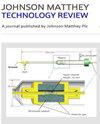微泡强化生物处理
IF 2
4区 化学
Q4 CHEMISTRY, PHYSICAL
引用次数: 1
摘要
微气泡以其大的表面积体积比而闻名,伴随着界面现象的加剧,突出的是更快速的气体交换。然而,对于生物加工,几十年来人们已经认识到,由于表面活性剂在界面上的负载,富含表面活性剂的发酵培养基阻碍了传质和可能的其他界面过程。本文重点关注微泡大小和气泡库的作用,分散的微泡足够小而不浮力,通过与微生物的碰撞以及微生物和微泡的自组装簇来介导其他模式的界面传递。这为产物气体提供了更直接的传质途径,可以直接释放到微泡中,扩散速度比液体介导的气体交换快~ 104。此外,分泌的具有两性特征的外部代谢物沿着微泡界面被吸收,为液体溶质的运输提供了比通过边界层扩散更快的途径。这些机制可以被共生或微生物工程等新兴领域所利用,以设计自组装的人工地衣分散结构,这些结构可以作为选定成分的支架。此外,这种设计的支架可以调节,以及微泡介导浮选分离或热微泡剥离的可控参数,以同时或原位去除产物。因此,分阶段去除产物具有减少分泌的外部代谢物对产生它们的微生物的抑制作用的好处。支持这些假设的证据是通过回顾文献得出的。特别是,最近在酵母和微藻在分散气泡库存在下的共同培养,以及分散的种子微气泡厌氧消化(AD)强化,提出了支持这些提出的人工地衣簇。本文章由计算机程序翻译,如有差异,请以英文原文为准。
Microbubble Intensification of Bioprocessing
Microbubbles are famed for their large surface area-to-volume ratio, with the promise of intensification of interfacial phenomena, highlighted by more rapid gas exchange. However, for bioprocessing, it has been recognised for many decades that surfactant-rich fermentation media hinders mass transfer and possibly other interfacial processes due to surfactant loading on the interface. This article focuses on the roles of microbubble size and bubble bank, dispersed microbubbles that are sufficiently small to be non-buoyant, in mediating other modes of interfacial transfer via collisions with microorganisms and self-assembled clusters of microorganisms and microbubbles. These provide a more direct route of mass transfer for product gases that can be released directly to the microbubble with ~10 4 faster diffusion rates than liquid mediated gas exchange. Furthermore, secreted external metabolites with amphoteric character are absorbed along the microbubble interface, providing a faster route for liquid solute transport than diffusion through the boundary layer. These mechanisms can be exploited by the emerging fields of symbiotic or microbiome engineering to design self-assembled artificial lichen dispersed structures that can serve as a scaffold for the selected constituents. Additionally, such designed scaffolds can be tuned, along with the controllable parameters of microbubble mediated flotation separations or hot microbubble stripping for simultaneous or in situ product removal. Staging the product removal thus has benefits of decreasing the inhibitory effect of secreted external metabolites on the microorganism that produced them. Evidence supporting these hypotheses are produced from reviewing the literature. In particular, recent work in co-cultures of yeast and microalgae in the presence of a dispersed bubble bank, as well as anaerobic digestion (AD) intensification with dispersed, seeded microbubbles, is presented to support these proposed artificial lichen clusters.
求助全文
通过发布文献求助,成功后即可免费获取论文全文。
去求助
来源期刊

Johnson Matthey Technology Review
CHEMISTRY, PHYSICAL-
CiteScore
4.30
自引率
4.30%
发文量
48
审稿时长
12 weeks
期刊介绍:
Johnson Matthey Technology Review publishes articles, reviews and short reports on science enabling cleaner air, good health and efficient use of natural resources. Areas of application and fundamental science will be considered in the fields of:Advanced materials[...]Catalysis[...][...]Characterisation[...]Electrochemistry[...]Emissions control[...]Fine and speciality chemicals[...]Historical[...]Industrial processes[...]Materials and metallurgy[...]Modelling[...]PGM and specialist metallurgy[...]Pharmaceutical and medical science[...]Surface chemistry and coatings[...]Sustainable technologies.
 求助内容:
求助内容: 应助结果提醒方式:
应助结果提醒方式:


